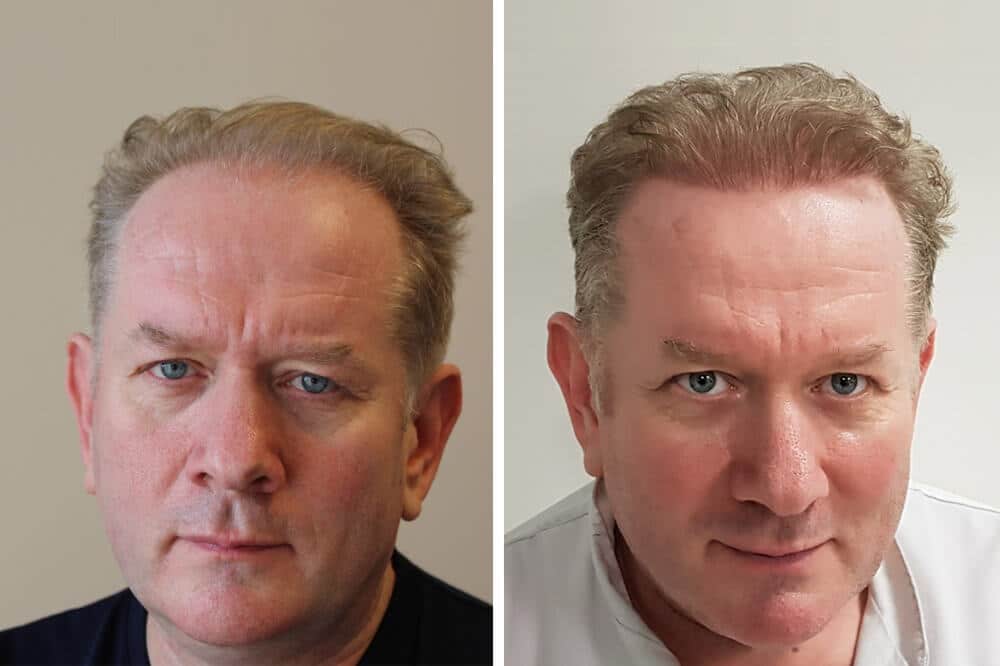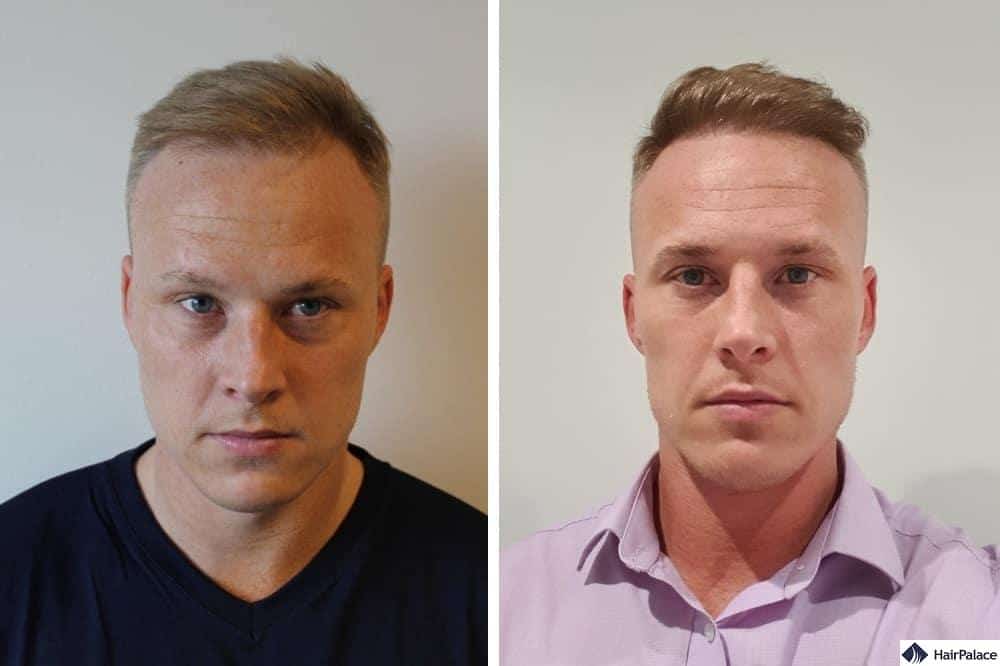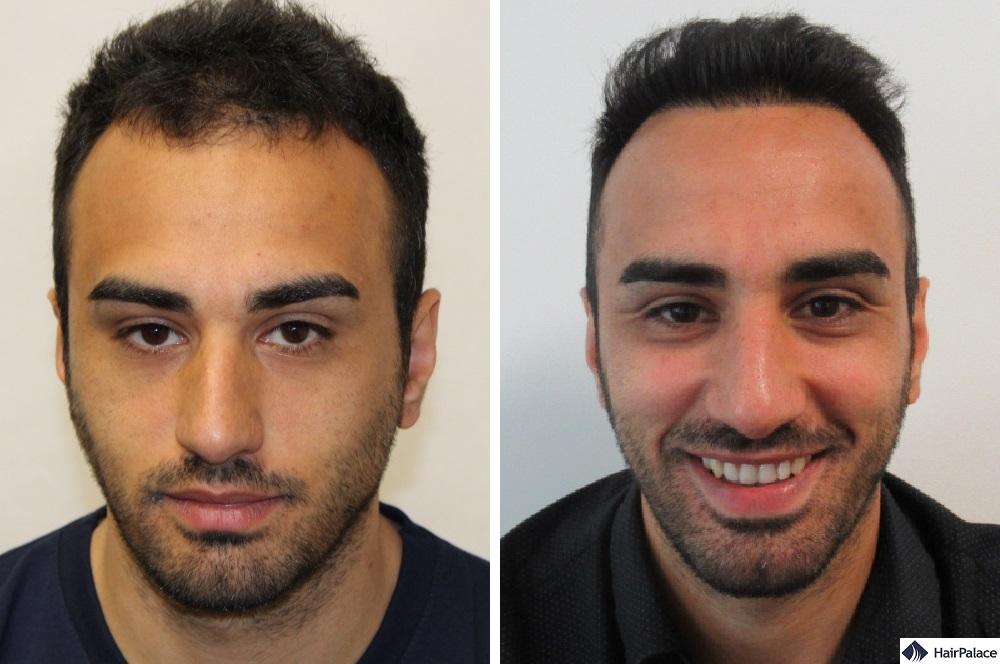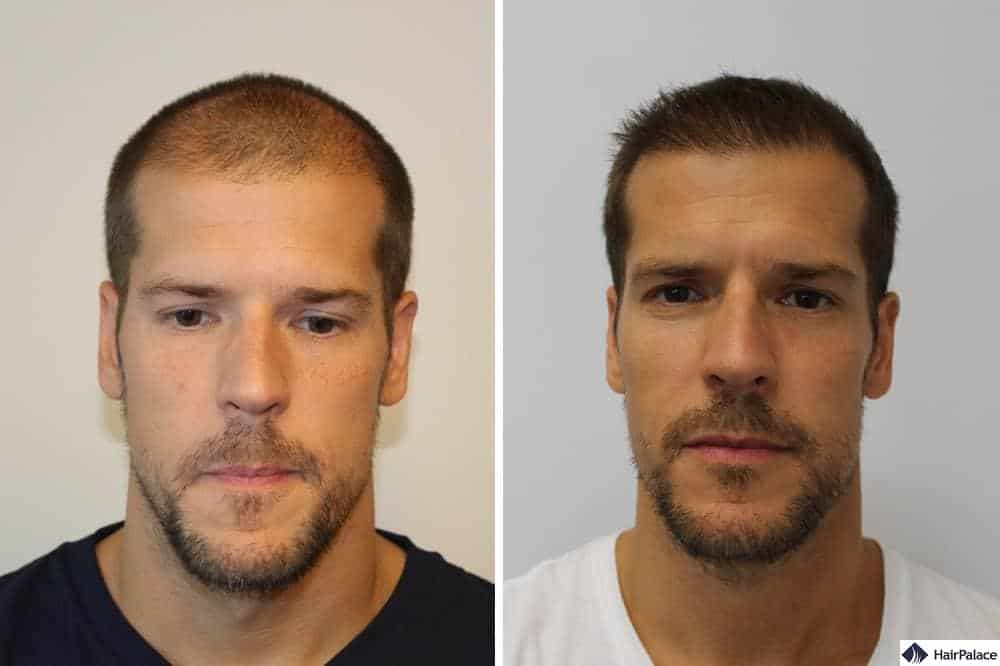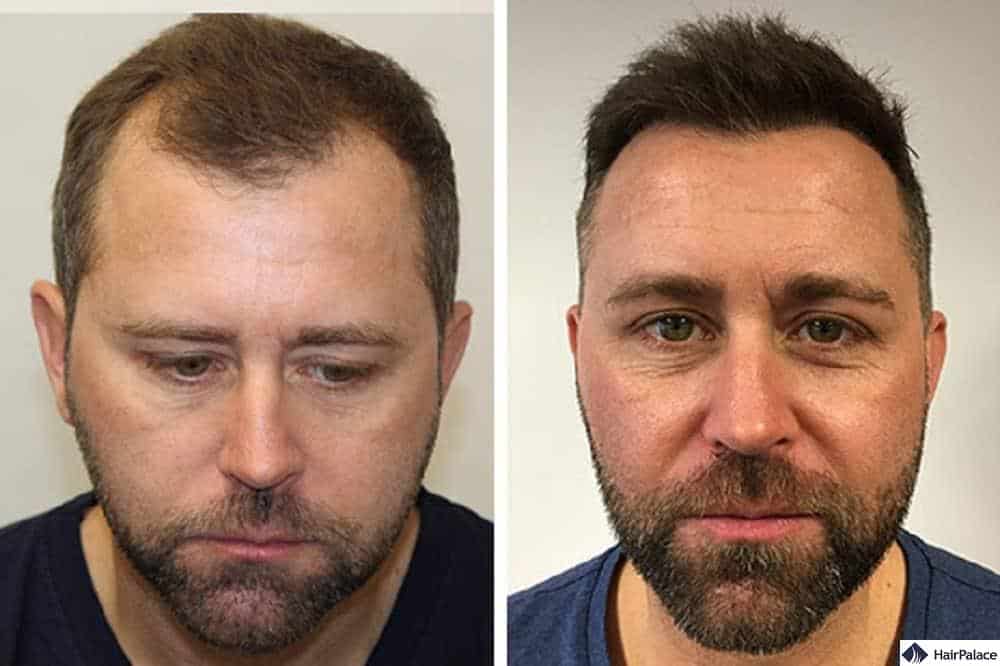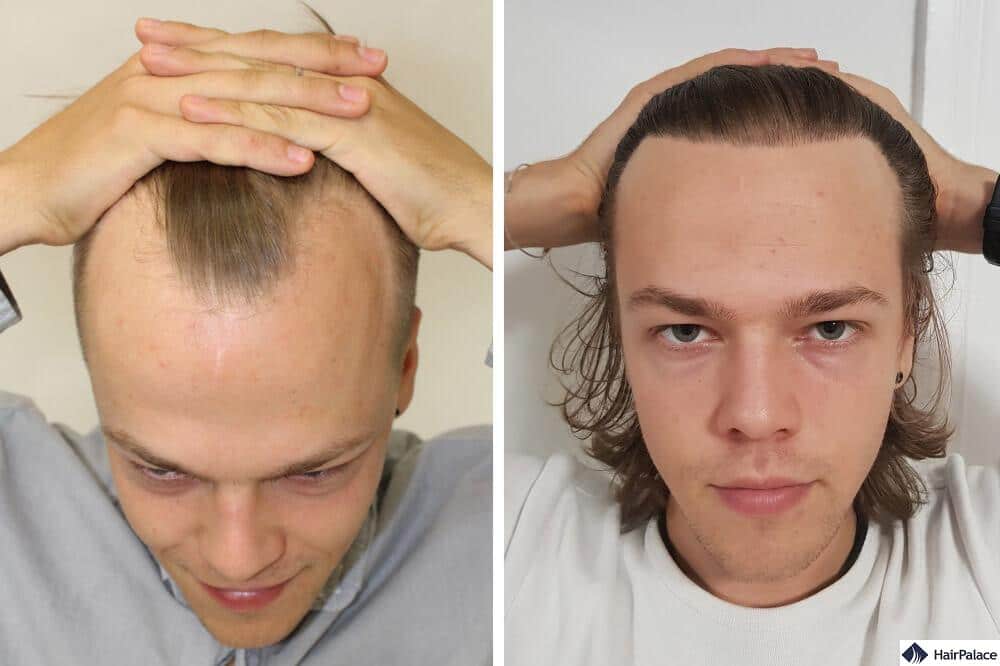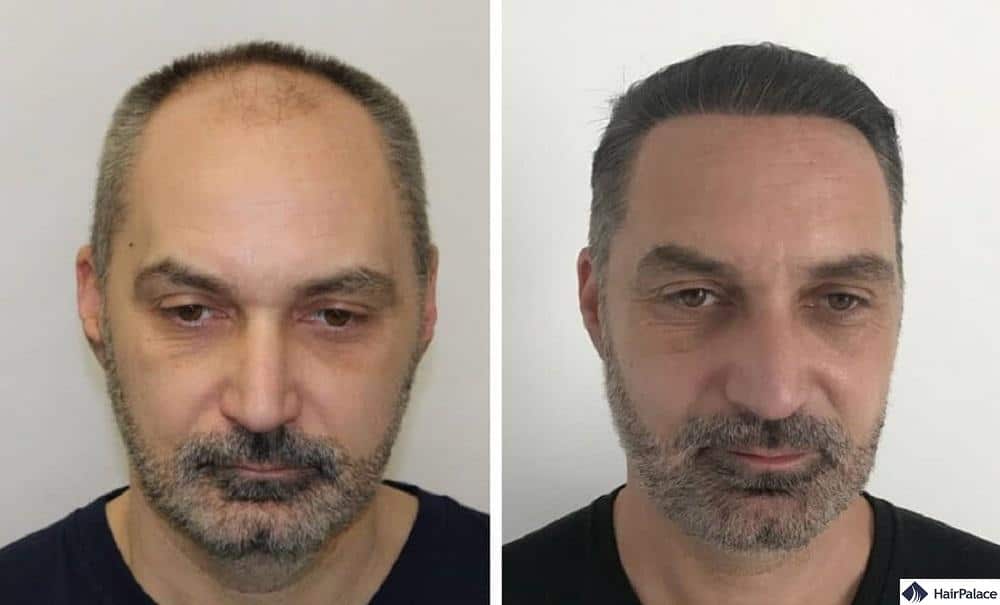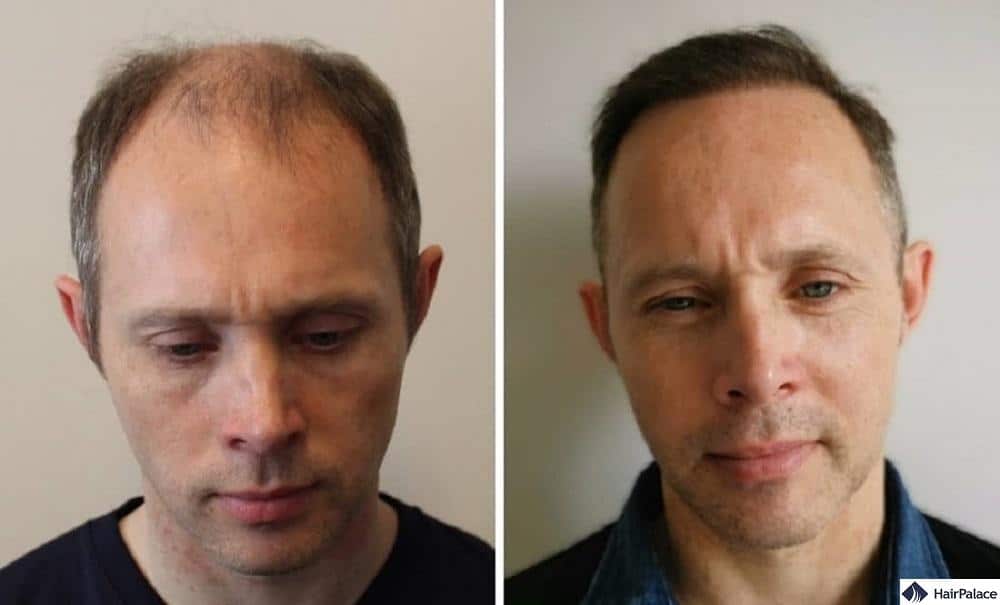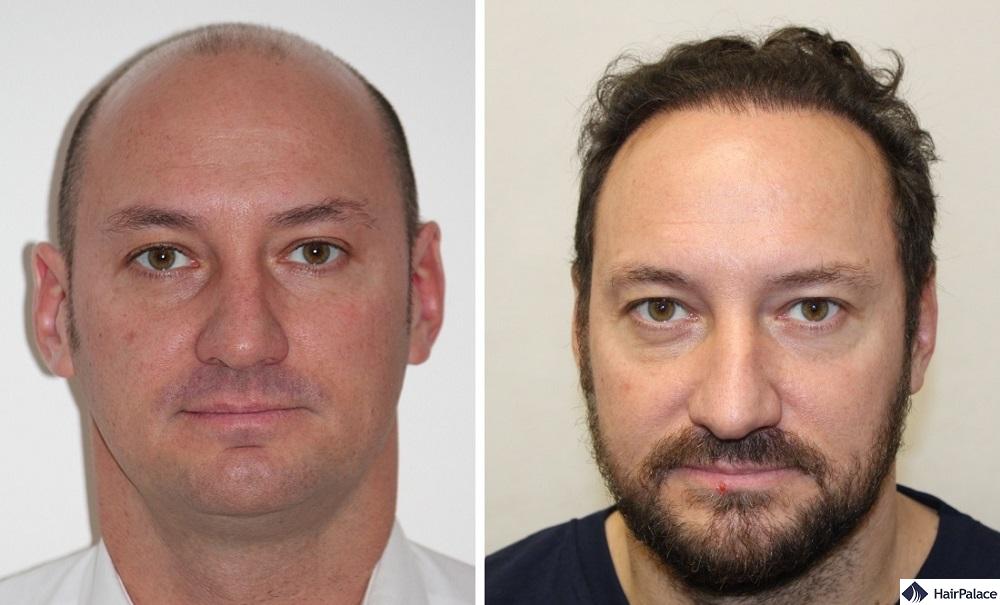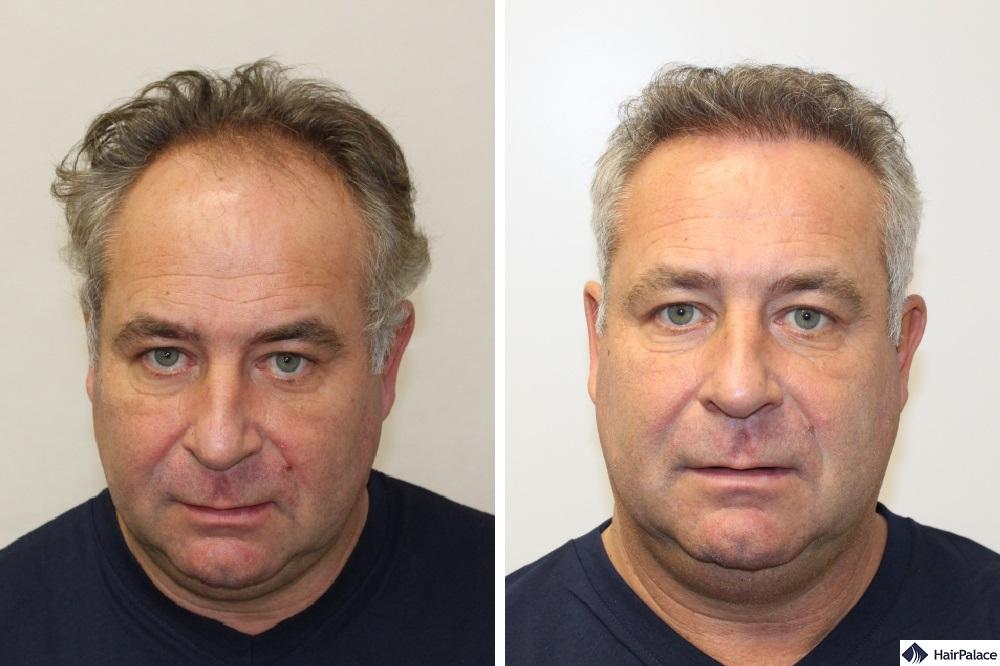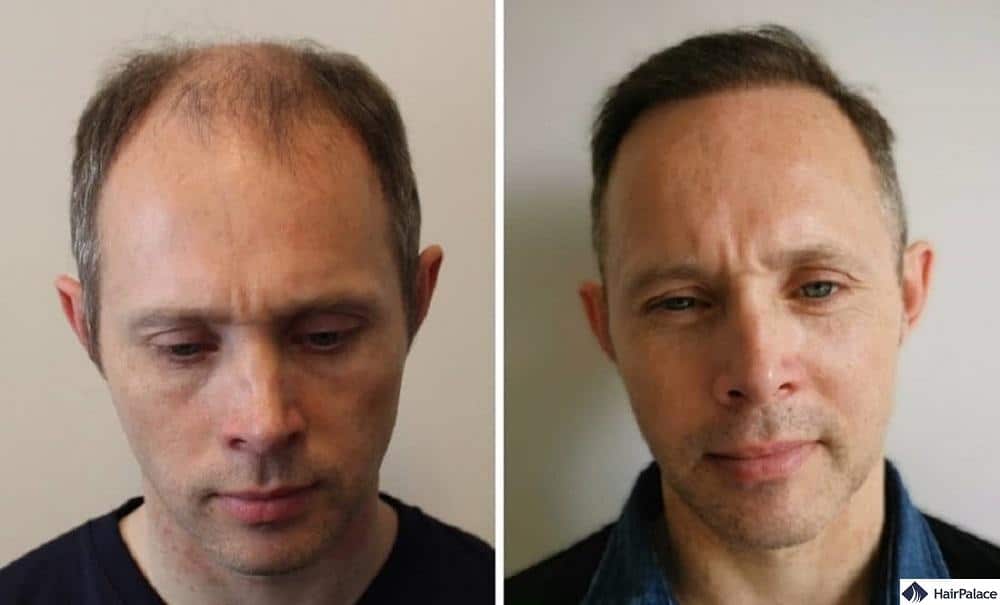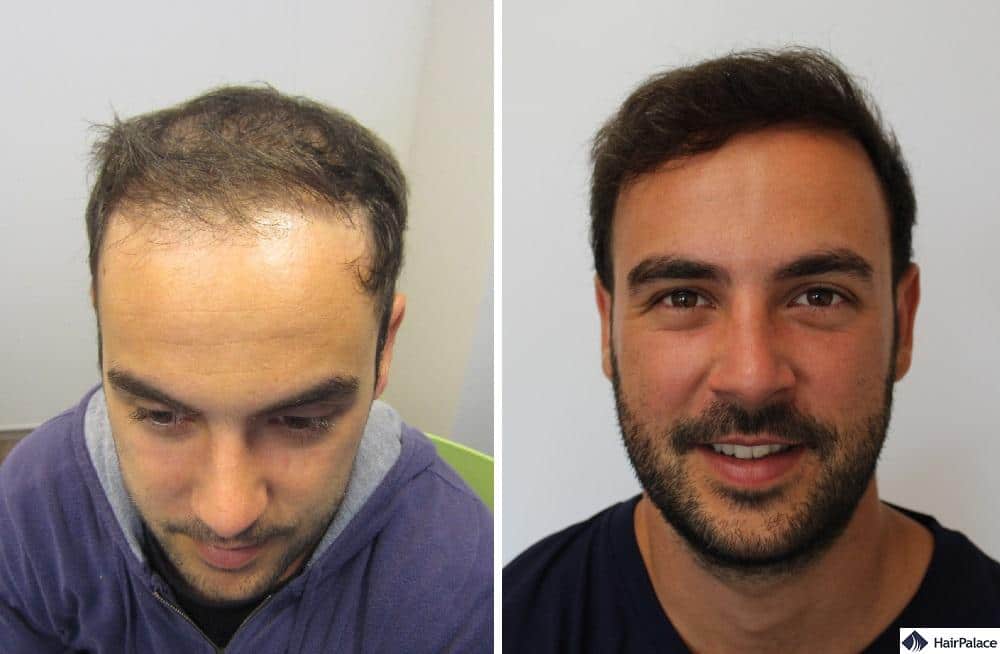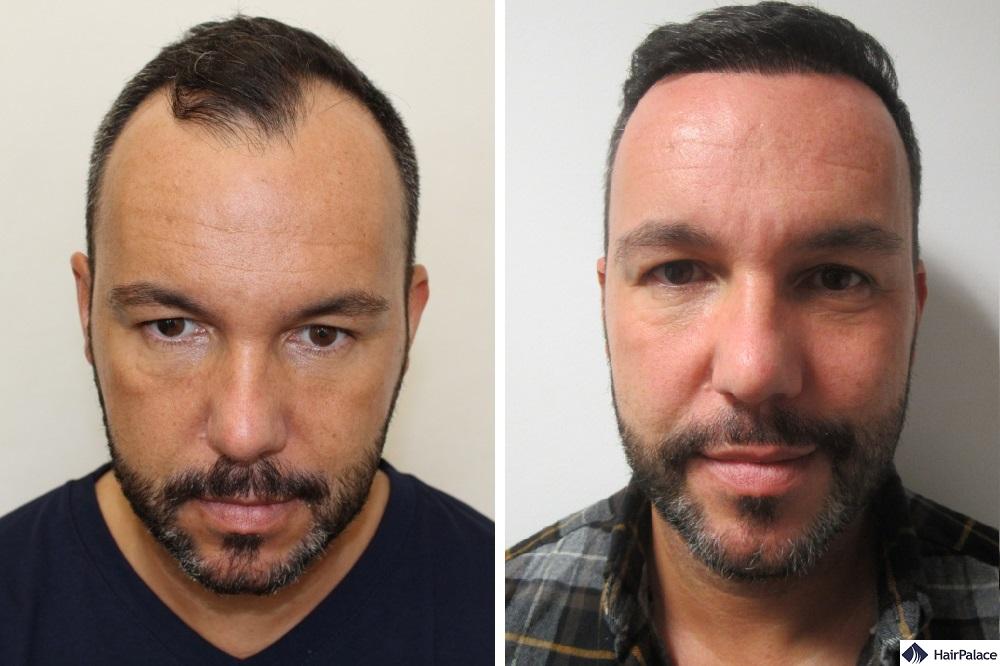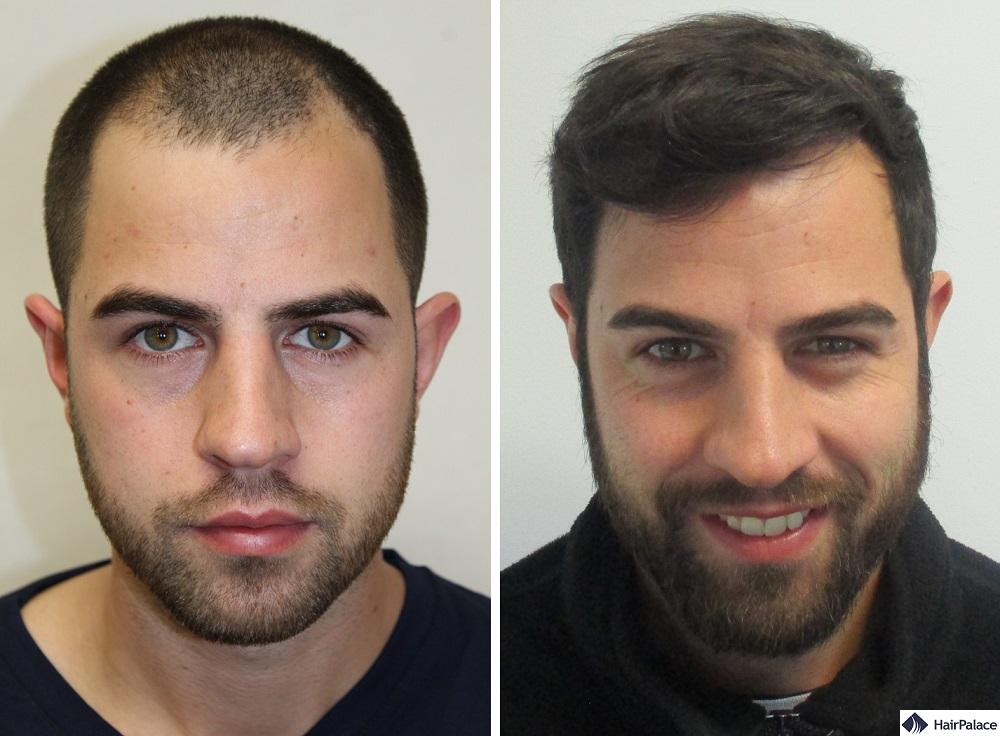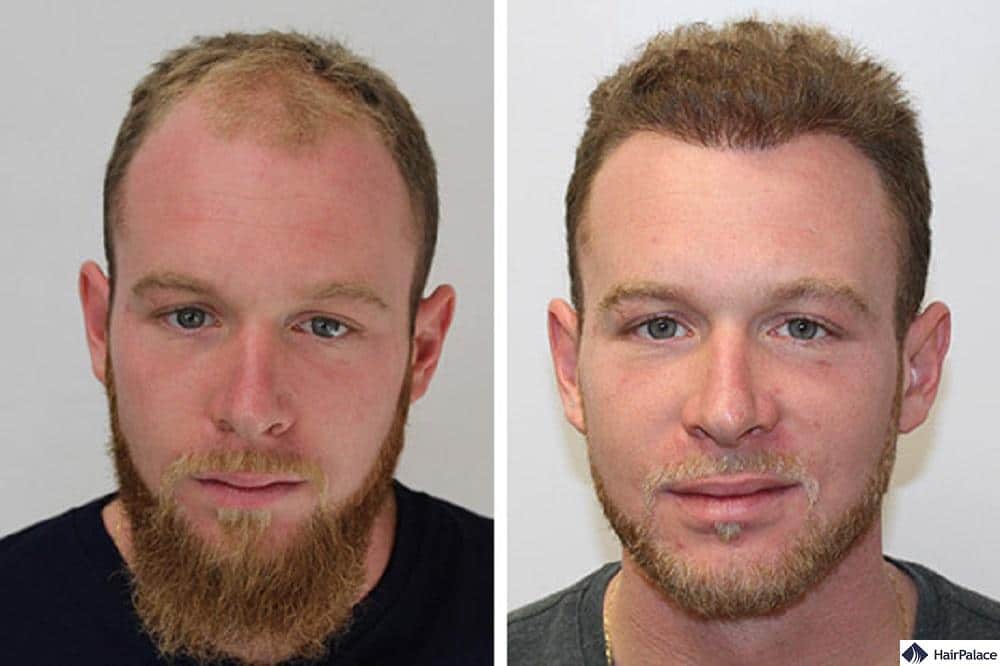Hair Transplant
Everything You Need to Know in 2025
- What is a hair transplant?
- Fast facts
- When to get a hair transplant?
- How much is a hair transplant?
- How does a hair transplant work?
- What to do after hair transplant?
- How long does a hair transplant last?
- Benefits of FUE hair transplant
- Can hair transplant fail?
- Hair transplant at HairPalace
What is a hair transplant?
During the procedure, surgeons extract hair follicles from the back or sides of the scalp and implant them into the balding areas.
The surgery is usually carried out under local anaesthesia and can take several hours, depending on the extent of hair loss being treated.
This treatment can restore hair growth with natural, seamless results.
Fast facts
| Hair transplant UK | |
|---|---|
| Number of patients in 2022 | 17,000 |
| Most clinics in | London |
| Average cost | £2000-15,000 |
| Average size of surgery | 2500 grafts |
| Procedure | |
| Most popular technique | FUE |
| Duration of surgery | typically 6 to 8 hours |
| Anaesthesia | local anaesthesia |
| Shaving | required to 1mm |
| Pain levels | none to slight |
| Common side effects | temporary swelling, redness, scabbing |
| Scarring | practically invisible |
| Aftercare & results | |
| Recovery | 7-14 days (depending on method) |
| Return to work | 2-5 days |
| Exercise | from 3-4 weeks post-op |
| Hair wash | gently from 2 weeks |
| Final result | 12-15 months post-op |
When to get a hair transplant?
The best time to perform hair transplant surgery is once hair loss has stabilised, usually after the early 30s.
If done too early, the progression of male pattern baldness can ruin the results, and you might end up with a patchy appearance.
A consultation with one of our surgeons can help you determine whether it’s the correct time to hair hair transplant surgery.
What type of hair loss is suitable for a hair transplant?
The FUE hair transplant procedure is a popular solution for patients affected by a receding hairline, balding crown, or male pattern baldness.
What age for hair transplant?
Instead of your age, your medical history and the characteristics of your hair loss will determine if Follicular Unit Extraction (FUE) is the right solution for you.
In general, you may be an ideal candidate for the procedure if:
- Your hair loss reached at least Stage 2 on the Norwood Scale
- You have been experiencing hair loss and thinning hair for more than 3 years
- Your hair loss pattern has stabilised
- Your hair at the back and sides of the head is dense enough to allow the extraction
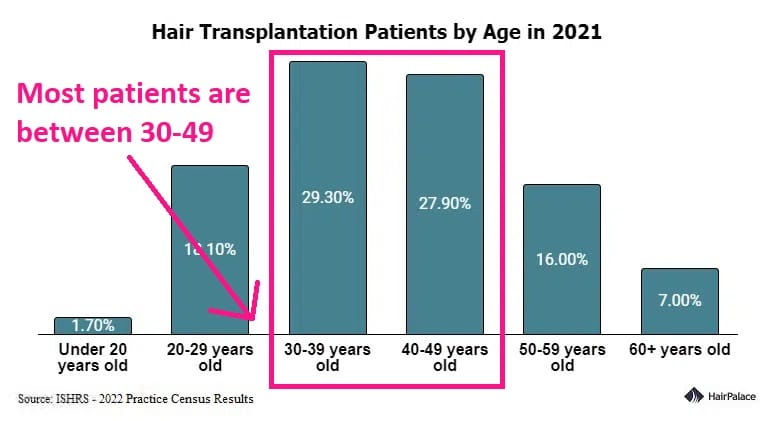
How much is a hair transplant?
Here at HairPalace, our hair transplant cost ranges from £ 1990 to £ 2290.
We offer hair transplant packages in Hungary (Budapest), allowing you to save 70% compared to the UK prices for the same quality!
Let’s take a look at what factors can influence the price of your hair transplant surgery:
- Number of hairs required
- Method used (FUT, FUE, or DHI)
- The clinic’s location
- Surgeon’s experience and reputation
- Aftercare and whether there is a guarantee
- Donor availability
Every year, thousands of patients choose to travel to Hungary for their procedures.
With travel costs being roughly £100 these patients save thousands of pounds (around £5000 on average) while receiving the same high-quality treatment they would get in the UK.
How does a hair transplant work?
A hair transplant involves harvesting healthy hair follicles from the donor region, typically the back or sides of the scalp, and carefully implanting them into areas affected by thinning or baldness.
The transplanted follicles are genetically resistant to hair loss, so they continue to grow naturally.
Over time, this restores hair density and creates a permanent, natural-looking result.
Typically, patients have 2000-3000 grafts implanted in a single session, depending on the state of their androgenetic alopecia.
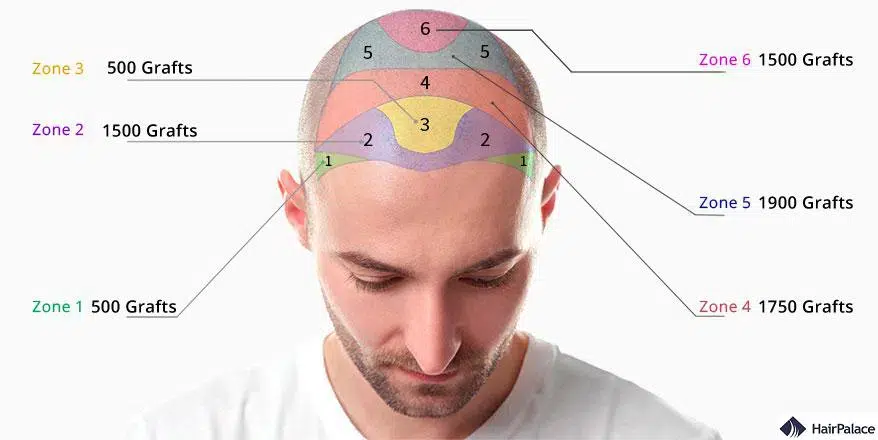
The smallest hair transplant hairline surgery usually involves zone 1 alone, which is the area of your temples.
Zone 2 covers most of the frontal region with the exception of your widow’s peak, that area is referred to as zone 3.
Zone 4 is practically a thick belt on the middle region of your scalp whereas zone 5 covers most of the crown area.
Lastly, zone 6 covers the vertex and the back of your scalp. The exact area that will be covered by the surgery will always be determined during your initial consultation.
How long does a hair transplant take?
The surgeries usually take 6-8 hours to complete, depending on how many hairs you need to achieve the best hair transplant results.
Here is what you can expect on the day of your hair loss surgery:
- Your hair will be cut short so the surgeon can see the existing hair precisely.
- The surgical sites will be cleaned and disinfected.
- The surgeon will administer local anaesthesia to numb the donor area.
- The hair follicles will be removed from the back and sides of the head.
- The assistants will clean the follicles and prepare them for implantation.
- The surgeon will numb the top of the scalp. Then, they prepare the tiny incisions on the recipient area.
- Then, they will implant the new follicles.
- The surgeon will clean the surgical sites again and put a bandage on the donor area.
Once the hair transplant procedure is finished and you’re all bandaged up you will return to your accommodation.
It’s important to go easy on yourself and get as much rest as you can after your FUE procedure.
Does hair transplant hurt?
Hair transplants are performed under local anesthesia, so you shouldn’t feel pain during the aesthetic surgery.
You may experience mild discomfort, pressure, or pulling sensations as the surgeon harvests individual hairs from the safe donor zone.
Afterwards, slight soreness or itching is common but usually manageable with medication.
Is a hair transplant permanent?
Hair transplantation is a permanent solution to baldness because the transplanted follicles are resistant to hair loss.
They continue to grow naturally for a lifetime. Proper care ensures long-lasting, natural results.
Does hair transplant leave scars?
All hair transplants leave tiny scars.
With FUE, there are small dot scars that are barely visible, while follicular unit strip surgery leaves a linear scar.
However, thanks to our revolutionary method, the FUE2 safe system, the tiny scars left behind in the donor area are virtually undetectable.
What to do after hair transplant?
After a hair transplant, follow your surgeon’s instructions carefully.
Avoid touching, scratching, or washing the scalp for the first few days, and sleep with your head elevated.
Protect the area from sun, exercise, and trauma until fully healed.
Contact your hair transplant clinic in case you’re in doubt; they will be happy to help you stay on track during recovery.
How long does a hair transplant take to heal?
Recovery after your hair transplant will be quick.
As these are minimally invasive, outpatient procedures, you can return home on the same day or the day after.
While each clinic has slightly different aftercare instructions, your recovery after the surgery will likely go as follows:
- Day 0: Remove bandages before you go to bed.
- Day 1: Start using saline spray.
- Day 2-4: Return to work.
- Day 7: Wash your hair gently.
- Day 14: Scalp must be free of scabs.
- After 3 weeks: Implanted hairs start to shed.
- After 3 months: New growth starts.
- After 6 months: Visible improvement in the density.
- After 12-15 months: The result is complete.
How long does a hair transplant last?
A hair transplant lasts a lifetime because the transplanted follicles are resistant to balding. The new hair grows permanently in its new location.
Although natural ageing may still thin the surrounding non-transplanted hair.
Hair transplant before and after
Your hair should keep growing as normal following an implantation. But the density of the hair can differ due to:
- The quality of the hair
- The hair’s shape (e.g., wavy, curly)
- The looseness of the skin on the scalp (scalp laxity)
- The number of follicles in the treatment area
Check out some of our stunning hair transplant before and after pictures below:
Is a hair transplant worth it?
A hair transplant is worth it in most cases, as it is the only permanent solution to baldness and an effective way to restore your natural look.
Beyond the aesthetic transformation, the procedure can also provide a significant boost to your confidence and help rebuild self-esteem.
What is the success rate of hair transplants?
HairPalace hair transplants have a success rate of 90-95%, meaning the vast majority of transplanted grafts survive and grow as expected.
We even provide a written guarantee: if less than 80% of the transplanted hairs take root, we will re‑implant the missing amount at no additional cost.
Benefits of FUE hair transplant
- Aesthetic change
By far the biggest advantage of a hair transplant is the aesthetic change patients experience. These procedures can help you regain your youthful appearance and self-esteem. - Increased confidence
Feeling good about your appearance will improve your self-esteem and increase your confidence. You can see this transformation on our hair transplant before and after pictures! - Natural look
During the surgery uses your own hair, so the result will look and feel natural. During the implantation, the surgeon will mimic the natural pattern and density of your hair to achieve full, seamless result. - Permanent result
Hair implants provide life-long results. The transplanted follicles will not be affected by hormones causing male pattern baldness, and will continue to grow in their new place. - Cost effective
The hair restoration surgery is a one-time expense for a lasting change. While alternative hair loss treatments are cheaper, they will remain a recurring expense, potentially for years. - Simple, low-risk procedure
Modern techniques allow you to restore the density of your hair in a 1-day surgery. While success rates are high, these minimally invasive procedures have low risk of complications, and mainly temporary side effects.
Can hair transplant fail?
A hair transplant can fail if the grafts don’t take root properly.
Causes may include poor surgical technique, infection, or inadequate aftercare.
Choosing an experienced clinic, such as Hair Palace, and following post-operative instructions can greatly reduce this risk.
Hair transplant at HairPalace – Dean’s experience
Listen to Dean and find out how he achieved the best hair transplant results at our clinic.
FAQ
A hair transplant is typically permanent. The transplanted hairs, taken from areas resistant to balding, usually retain this resistance once moved. However, the patient’s original hair in the treated area may continue to thin over time. Regular maintenance and treatments might be needed to address further hair loss.
The initial healing after a hair transplant usually takes 10 to 14 days. However, complete healing and settling of transplanted follicles can take a few weeks to a couple of months.
Yes, a hair transplant is generally permanent, but the patient’s original hair in the treated area may continue to thin or recede over time.
Hair transplants are generally safe when performed by experienced and qualified professionals, but like any surgical procedure, they carry some risks and potential side effects.
The best age for a hair transplant is typically in one’s 30s or older when hair loss patterns are more established and predictable. However, in many cases, the hair loss stabilises earlier, or much later, so eligibility is more about the nature of your hair loss rather than your age.
Last medically reviewed on September 4th, 2025
- ISHRS: 2025 Practice Census Resultshttps://ishrs.org/wp-content/uploads/2025/05/report-2025-ishrs-practice-census_05-12-25-final.pdf
- Kanti V, Messenger A, Dobos G, et al. Evidence-based (S3) guideline for the treatment of androgenetic alopecia in women and in men - short version. J Eur Acad Dermatol Venereol. 2018;32(1):11-22.https://doi.org/10.1111/jdv.14624
- Vogel James E et al. Hair Restoration Surgery: The State of the Art. Aesthetic Surgery Journal 2013;1:33http://dx.doi.org/10.1177/1090820X12468314
- Zito PM, Raggio BS. Hair Transplantation. Updated 2021https://www.ncbi.nlm.nih.gov/books/NBK547740/
